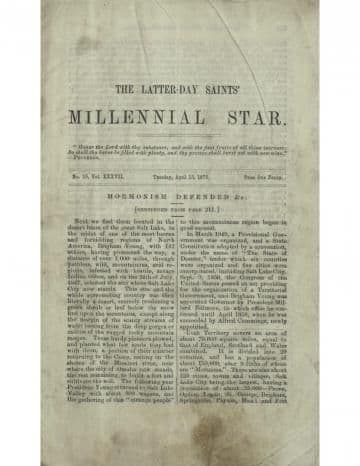Magazine
Old America: Jared

Title
Old America: Jared
Magazine
The Latter Day Saints' Millennial Star
Publication Type
Magazine Article
Year of Publication
1875
Authors
O., G. M. (Primary)
Number of Pages
231
Date Published
13 April 1875
Volume
37
Issue Number
15
Abstract
This series gives a brief synopsis of Jaredite history including their sailing to the American continent from the Tower of Babel. It also cites many ancient American flood myths that relate to the biblical story of the flood at the time of Noah. The third and final part discusses the myths contained in the Popol Vuh.
OLD AMERICA.
JARED.
[Continued from page 199.]
An important Manuscript work written two hundred years ago by Francisco Ximenes, is preserved in Guatemala. It is a translation from some of the “old books” of the natives; one of them known as the “Popol-Vuh,” in the native tongue (Quiche), has the Spanish translation annexed. This translation remained in Guatemala, unprinted and unknown, until discovered in our time by Brasseur de Bourbourg, who has translated the work into French. The “Popol-Voh’’ was written in 1658, as an abridged reproduction of a very ancient Quiche book containing the history, traditions, religion and cosmogony of the Quiches. Professor Baldwin, speaking of this book, says: “It shows us their conceptions of the Supreme being, and his relation to the world; it enables us to see what they admired in character, as virtue, Heroism, nobleness, and beauty; it discloses their mythology, and their notions of religious worship; in a word, it bears witness to the fact that the various families of mankind are all of “one blood,” so far at least, as to be precisely alike in nature.” The cosmogony of the Quiches is undoubtedly far more ancient than the beginning of this people as a nation. According to the “Popol-vuh,” the world had a beginning; there was a time when it did not exist; only “heaven” existed; below all was emptiness. Nothing existed in this space; neither man, animal, earth or tree. Then appeared water, over which divine beings moved in brightness created earth; it came into being like vapor, and mountains rose above the waters. Thus was earth created by the Heart of Heaven. Next came the creation of animals; but the gods were disappointed. They could not tell their names, nor worship the Heart of Heaven. It was then resolved that man should be created. First he was made of earth, but the flesh had no cohesion; he was inert; he could speak, but could not move, and had no mind; therefore he was consumed in the water. Next, man was made of wood; they multiplied, but had neither heart nor intellect, and could not worship, so they withered up. Man was then made of a tree called tzite, and woman of the pith of a reed, but they could not think, speak or worship, and were destroyed, all save a small remnant, which still exists as a race of small monkeys, found in forests. A fourth attempt was successful, but the circumstances attending this creation remain veiled in mystery. It took place before the beginning of dawn, before the sun or moon; it was a wonder work of the Heart of Heaven. Four men were created; they could reason, speak and see in such a manner as to know all things at once. They worshiped the creator, giving Him thanks for their existence and the manifold blessings they enjoyed; but the gods, frightened and dismayed, breathed clouds or mist over their eyes, to limit their vision, and caused them to be men, not gods. While the four men were asleep, the gods made them beautiful wives, and from these came all the inhabitants of the earth.
Whether the origin of this interesting tradition comes from Jared or from Nephi, it is impossible to say. We only know that it bears witness to the fact that ages long past a race of people inhabited our continent, far advanced morally and religiously above the nations discovered by the Europeans of the sixteenth century; and it also bears witness of the fact that ages long past a race of men worshiped and adored the true God, and undoubtedly had Prophets and seers among them.
Some speculators have represented the human race as a race of savages, until a comparatively modern date. Such an idea is most preposterous, and not worthy of the time or thought of a sensible man, and merely shows the dreaminess of unbridled fancy. The Quiche manuscript was certainly not written by a barbarian. G.M.O.
—Juvenile Instructor
Subject Keywords
Bibliographic Citation
Terms of use
Items in the BMC Archive are made publicly available for non-commercial, private use. Inclusion within the BMC Archive does not imply endorsement. Items do not represent the official views of The Church of Jesus Christ of Latter-day Saints or of Book of Mormon Central.